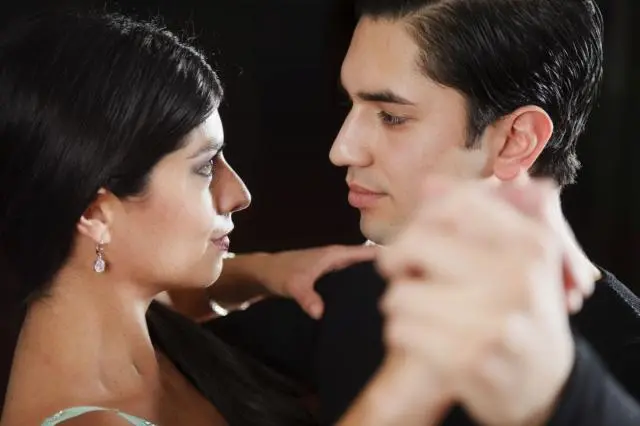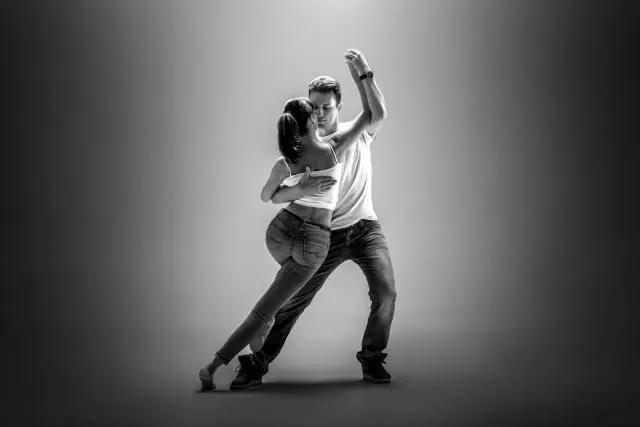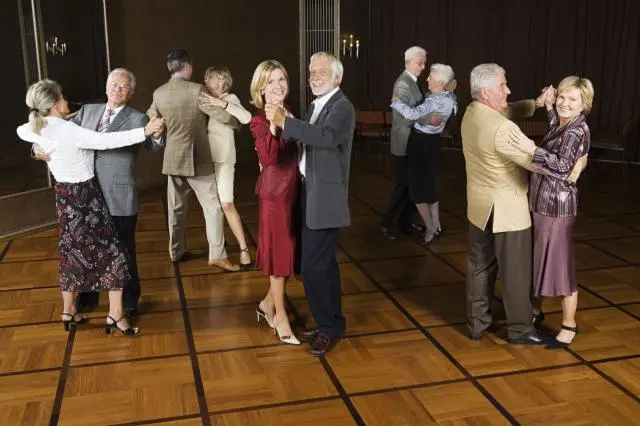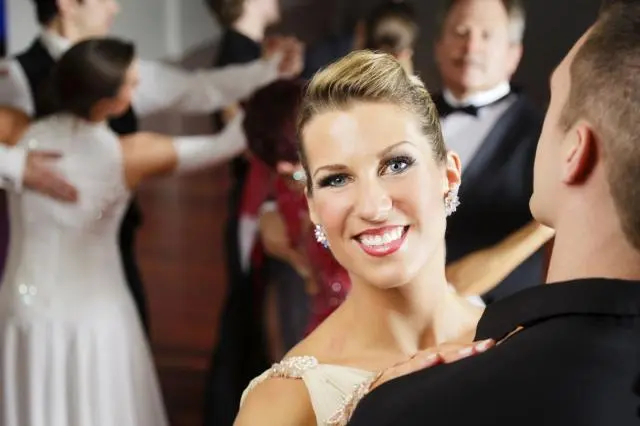Slow waltz in America
The classic among standard dances
- The Slow Waltz and its special features
- How to dance a slow waltz
- Basic Figures for Beginners
- Figures for advanced users
- Figures for professionals
- The ten most popular slow waltz songs
- Learn the Slow Waltz
The Slow Waltz and its special features
The Slow Waltz is a very well-known standard and ballroom dance that is based on a ¾ beat and is also often danced as an opening dance at weddings. Its frequent appearance at events makes it a real classic among the numerous dances. Above all, the calm and flowing movements and turns that are typical of this dance ensure a particularly harmonious and romantic atmosphere between the dance partners. Anyone who has heard of the slow waltz will certainly know that there are different types. The Slow Waltz is also called the English Waltz and should not be confused with the Viennese Waltz. There are a few differences between the two dances that you should consider in order to choose the right one. In contrast to the Slow Waltz, the Viennese Waltz requires more space and sweeping turns. Because the Viennese Waltz is danced faster, it is also more difficult for most dancers to learn.
How to dance a slow waltz
Below we give step by step instructions on how to dance the Slow Waltz:
- Starting position: Stand in a closed dance position with your partner, with both of you facing each other and placing your hands together. The man leads the woman in this dance.
- Step forward: The man begins the dance with his left foot and takes a slow step forward. The woman takes a slow step backwards with her right foot.
- Step to the side: The man now takes a slow step to the side with his right foot, while the woman takes a slow step to the side with her left foot.
- Step Back: The man takes a slow step backwards with his left foot while the woman takes a slow step forward with her right foot.
- Pause: Both partners now take a break and hold their position.
- Step to the side: The man now takes a slow step to the side with his left foot while the woman takes a slow step to the side with her right foot.
- Step forward: The man takes a slow step forward with his right foot while the woman takes a slow step back with her left foot.
- Pause: Both partners now take a break and hold their position.
Repeat the steps to the rhythm of the music and combine them in different ways. This is how you vary your dance and start creating your own slow waltz. It is important to maintain good posture and maintain eye contact with your partner while dancing. Over time, it will become easier and easier to dance the slow waltz and even have joy and fun while doing it.
Basic figures for beginners
- Basic step: The basic step is the basic movement in the slow waltz. There are many different variations of the basic step, but the simplest consists of a side step to the left, a step to the right, and a step forward.
- Left turn: In left turn, the man spins around the woman while dancing with her. The man begins by stepping to the left and beginning a spin while the woman remains in place. Then the man joins the woman again.
- Right rotation: Right rotation is similar to left rotation but in the opposite direction. The man begins by taking a step to the right and then spins around the woman while she remains in place.
- Promenade: On the promenade, a man and woman walk side by side and walk sideways. There are many variations of the promenade, but the simplest is that the woman strides left while the man strides right, and then the man strides left while the woman strides right.
- Alternating step: The alternating step consists of a sideways step to the left for the man, followed by a sideways step to the right for the woman, followed by a common step nach in front. Then the step is repeated in the other direction.
These figures form the basis for more advanced variations in the Slow Waltz. It is important to learn these first before gradually adding more steps and figures. If you feel confident with the basic steps, you can continue with the following figures for advanced and professional users.
Figures for advanced users
- Fleckerl: Fleckerl is a rotating figure in which the man spins the woman in a spiral around him and she makes several turns.
- Kontrafleckerl: Kontrafleckerl is a variation of Fleckerl in which the woman turns the man while he walks backwards.
- Hockey stick: Hockey stick is a combination of figures in which the man performs a turn and the woman slides under his arm.
- Step Sequences: There are many step sequences used by advanced dancers to expand their technique and repertoire. Examples include the open reverse turn, the double reverse spin, the fallaway whisk and the weave.
- Lifting Figures: Lifting figures are an advanced technique performed by experienced dancers. For example, the woman is lifted into the air or the man turns around while the woman stretches her legs in the air.
It is important to note that these figures and techniques require a high level of technical skill, coordination and body control. Therefore, one should master the basic steps of the Slow Waltz and feel really confident before attempting these more advanced figures.
Figures for professionals
If you want to improve your slow waltz skills at the highest level, the following figures for professionals are just the thing for you:
-
Reverse Fleckerl: Reverse Fleckerl is a more complex variation of Fleckerl in which the woman turns the man while he walks backwards. The woman makes several turns as she slides under the man's arm.
-
Natural Turn with Hesitation: Natural Turn with Hesitation is a combination of figures in which the man performs a turn and then remains in place while the woman brings her legs into a kind of scissors and rotates around him.
-
Oversway: Oversway is a lifting figure in which the woman is lifted into the air and placed in a diagonal position while the man stands beneath her.
-
Fallaway Reverse and Slip Pivot: Fallaway Reverse and Slip Pivot is a combination of figures where the man goes backwards and the woman makes a turn to get around him.
-
Continuous Hover: Continuous Hover is a more complex step sequence in which the man and woman continuously perform hover steps, leaning their bodies against each other and moving in elegant, fluid movements.
It is important to note that these figures and techniques require a high level of technical skill, coordination and body control. Therefore, one should master the basic steps of the Slow Waltz and feel really confident before attempting these more advanced figures.
The ten most popular slow waltz songs
No matter whether it’s a wedding, a dance school or a club – every dance has the right music. The slow waltz in particular has an advantage here: there are countless songs that you can choose from for this classic ballroom dance. Here are some popular slow waltz songs:
- "Unchained Melody" by The Righteous Brothers
- "Can't Help Falling in Love" by Elvis Presley
- "Moon River" by Andy Williams
- "Wonderful Tonight" by Eric Clapton
- "The Way You Look Tonight" by Frank Sinatra
- "My Heart Will Go On" by Celine Dion
- "When a Man Loves a Woman" by Percy Sledge
- "At Last" by Etta James
- "You Are the Love of My Life" by Sam Cooke
- "True Love" by Bing Crosby and Grace Kelly
These songs are timeless classics and are often played at weddings, dances and other events where slow waltzes are danced. However, it is important to note that there are no hard and fast rules as to which songs are suitable for the slow waltz. Any song with a slow, steady rhythm can be danced as a slow waltz, as long as it is appropriate for the dancers and their abilities.
Learn slow waltz
Learning the slow waltz depends on various factors, such as your personal sense of rhythm, your body control and your experience in dancing. Some people learn the slow waltz faster than others, depending on their individual ability to coordinate and learn movements.
For beginnersLearning the basic steps of the Slow Waltz can take a few weeks, while intermediate and professional dancers need to learn more complex figures and techniques that require more time and practice. However, it is important to be patient and not get discouraged if it takes a little longer to master the Slow Waltz.
To speed up the process, it's helpful to practice regularly and hire a qualified dance instructor who can give you step-by-step instructions and feedback on your moves. In addition, online dance courses, books and videos can be a useful addition to your lessons and help you deepen your knowledge and skills in the slow waltz. If you have mastered the first dance steps and would like to deepen your knowledge with a charming partner, then it's best to look for a suitable dance partner for the Slow Waltz at Lets-Dance Dance partner for the Slow Waltz . Simply register, create a profile and indicate what dance level you are at. You're sure to find the right dance partner near you.
Other dance partners
Shop
Popular blog posts about dancing
Create your dance profile on Lets-Dance
Register your dance school
Top cities
Top dances



